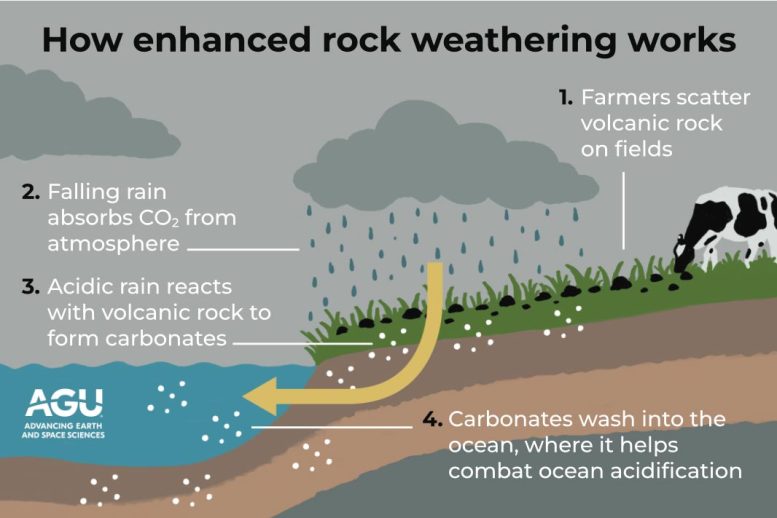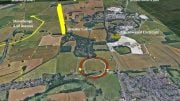
Incorporating crushed volcanic rocks into agricultural fields can significantly contribute to carbon dioxide reduction, with tropical regions offering the most promise for this climate mitigation strategy. Credit: SciTechDaily.com
Adding crushed volcanic rocks to agricultural fields can both improve the soil and suck down carbon dioxide. Doing so in the hot, humid tropics would be most efficient, a new study finds.
- Enhanced rock weathering makes use of a natural geologic process to store carbon long-term
- Applying 10 tons of basalt dust per hectare of cropland globally could sequester up to 217 gigatons of carbon dioxide in 75 years, above the IPCC’s lower threshold of carbon dioxide removal needed to reach climate goals, along with emissions reductions
- Farms in the tropics have the biggest and fastest return on investment
Global Agricultural Climate Strategy
Farmers around the world could help the planet reach a key carbon removal goal set by the Intergovernmental Panel on Climate Change (IPCC) by mixing crushed volcanic rocks into their fields, a new study reports. The study also highlights wet, warm tropics as the most promising locations for this climate intervention strategy.
The study provides one of the first global estimates of the potential carbon dioxide drawdown from basalt application on agricultural fields worldwide. It was published in Earth’s Future, AGU’s journal for interdisciplinary research on the past, present and future of our planet and its inhabitants.
Enhanced Rock Weathering: A Promising Approach
This type of climate intervention is called enhanced rock weathering. It takes advantage of the weathering process, which naturally sequesters carbon dioxide in carbonate minerals. The idea is simple: speed up weathering in a way that also benefits people. When used in parallel with emissions reductions, it can help slow the pace of climate change.
And it may be a safer bet than other carbon drawdown approaches, according to the study authors.
“Enhanced rock weathering poses fewer risks compared to other climate interventions,” said S. Hun Baek, a climate scientist at Yale University who led the study. “It also provides some key benefits, like rejuvenating depleted soils and countering ocean acidification, that may make it more socially desirable.”
The new study explores the potential of applying crushed basalt, a fast-weathering rock that forms as lava cools, to agricultural fields around the world and highlights which regions can most efficiently break down the rocks.

A climate intervention strategy called enhanced rock weathering, if applied globally, could help meet a key IPCC goal for slowing climate change, according to new research published in the AGU journal Earth’s Future. Enhanced rock weathering improves soil health, sequesters carbon, and combats ocean acidification. Credit: AGU
“There’s tremendous potential here,” said Noah Planavsky, a geochemist at Yale University who co-authored the study. “Although we still have things to learn from a basic science perspective, there is promise, and we need to focus on what we can do from market and finance perspectives.”
A previous study used a separate method of calculating carbon dioxide removal to estimate carbon drawdown by the year 2050, but the researchers wanted to look beyond country borders and further into the future.
The researchers used a new biogeochemical model to simulate how applying crushed basalt to global croplands would draw down carbon dioxide, to test the sensitivity of enhanced rock weathering to climate and to pinpoint the areas where the method could be most effective.
Research Findings and Future Implications
The new model simulated enhanced rock weathering on 1,000 agricultural sites around the world under two emissions scenarios from 2006 to 2080. They found that in the 75-year study period, those agricultural sites would draw down 64 gigatons of carbon dioxide. Extrapolating that to all agricultural fields, representing the world’s total potential application of this strategy, up to 217 gigatons of carbon could be sequestered in that time period.
“The latest IPCC report said we need to remove 100 to 1,000 gigatons of carbon by 2100 in addition to steeply reducing emissions to keep global temperature from rising more than one and a half degrees Celsius,” said Baek. “Scaling up to global croplands, the estimates of carbon removal we found are roughly comparable to the lower end of that range needed to have a fighting chance of meeting those climate goals.”
Because weathering progresses more quickly in hot and wet environments, enhanced rock weathering would work more quickly in tropical regions than higher latitudes, the study highlights. Farmers and companies looking to invest in carbon drawdown solutions make cost- and carbon-efficient choices by targeting basalt application in tropical fields.
The model revealed another promising result: Enhanced rock weathering works just as well, if not a little better, in warmer temperatures. Some other carbon drawdown approaches, such as those that rely on soil organic carbon storage, become less effective with continual warming.
“Enhanced rock weathering is surprisingly resilient to climate change,” Baek said. “Our results show that it’s relatively insensitive to climate change and works about the same under moderate and severe global warming scenarios. This gives us confidence in its potential as a long-term strategy.”
Farmers already apply millions of tons of limestone (a calcium carbonate rock that can either be a carbon source or sink) to their fields to deliver nutrients and control soil acidity, so gradually changing the rock type could mean a smooth transition to implementing enhanced rock weathering at scale, Planavsky said.
Enhanced rock weathering has been applied on small scales on farms around the world. The next step is working toward “realistic implementation,” Planavsky said.
For more on this study, see How Farmland Can Fight Global Warming.
Reference: “Direct evidence for atmospheric carbon dioxide removal via enhanced weathering in cropland soil” by Iris O Holzer, Mallika A Nocco and Benjamin Z Houlton, 18 October 2023, Environmental Research Communications.
DOI: 10.1088/2515-7620/acfd89









While weathering may be free, the basalt isn’t. One has to find a source of basalt near where it is intended to be used, which may be challenging in the tropics because it is usually already weathered and buried deeply. A good analog for the basalt is gravel or crushed aggregate used for construction, or phosphate rock applied to fields for fertilizer. Typically, the major cost for gravel is transportation from the source to where it is needed, which runs about at least $30 to $50/ton for short distances. However, basalt, which is tough rock, will have to be blasted, excavated, transported to a processing plant, crushed to a fine size, screened, and if it is going to be transported a long distance, perhaps bagged. It is the transportation costs that will be challenging because of extra handling. However, the blasting costs will probably be higher than for limestone because of the toughness, and because it will have to be crushed and screened finer than road aggregate, the sizing-process costs will be higher than for stream sediments or abundant limestone. However, the costs that need to be considered aren’t just money. Typically, mining operations use diesel powered excavators and haulage trucks, releasing CO2 in their operation. If the material has to be shipped by boat, that will also require the burning of oil, again releasing CO2. Therefore, besides looking at the dollar costs, one needs to evaluate the net CO2 removal after taking into account the release of CO2 from the ammonium nitrate/fuel oil explosives used for blasting, the diesel fuel and bunker oil used to transport the comminuted product, and the costs of comminution ( https://en.wikipedia.org/wiki/Comminution ).
Yes, basalt or other mafic rocks can be used to sequester CO2. However, strangely, there is no mention of the costs for a net reduction in atmospheric CO2. There is no shortage of basalt flows throughout the world, but they aren’t always near where they would be most useful. Were there any geologists or mining engineers involved in the study? Lastly, society isn’t enamored with mining.
Welcome to choose from me